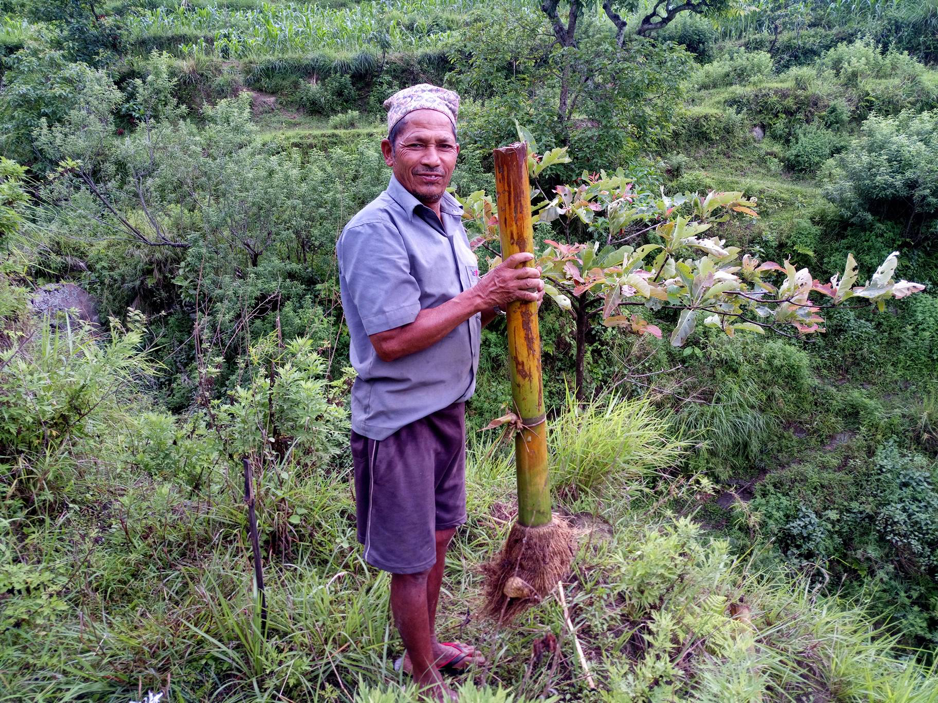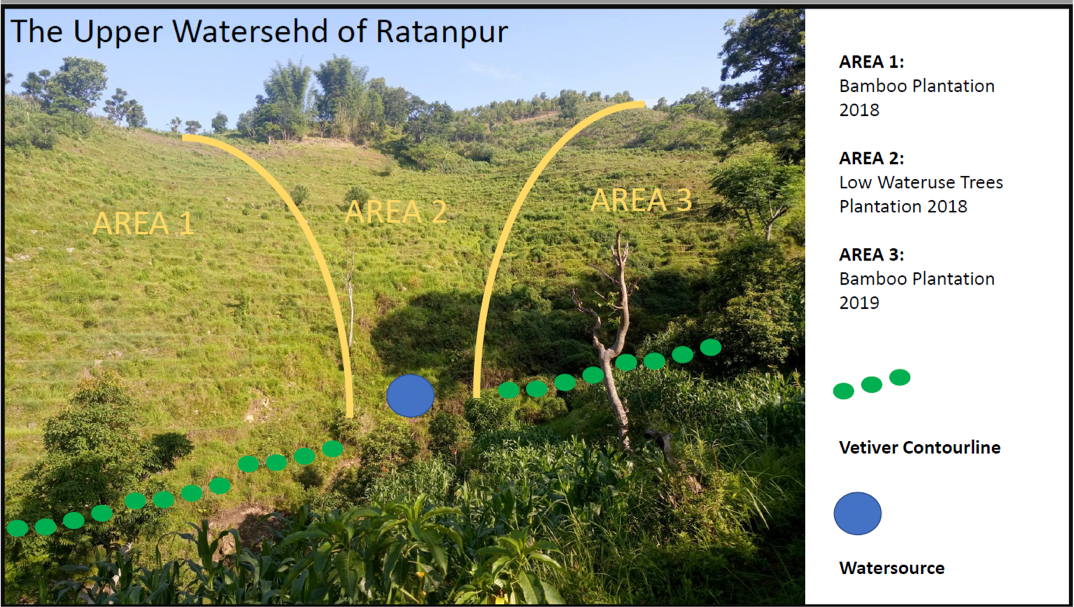Bamboo reforestation for watershed conservation
From a distance, Nepal appears to be a county consisting of high mountains covered in snow. Indeed, this magnificent landscape with its huge water reservoirs of snow, ice and glaciers can be found in wide areas ranging over the north, however further south in the Midmountain- and the Terai- region, the temperatures increase dramatically and people face an intense dry season. The reforestation with multi-purpose forest gardens is expected to replenish water sources and guarantee access to water for the adjacent villages.
The village of Ratanpur in Tanahun, Nepal, where the Ithaka project “Forest gardens for Closing the Global Carbon Cycle” is situated, is facing severe water shortages in the dry season. Most of its natural springs have gone dry, while the remaining ones have suffered decreases in flow. Together with the local population, Ithaka is working on different watershed conservation activities to secure the availability of this precious resource into the future.

Figure 1: A local farmer preparing bamboo cuttings (culms) for planting in the watershed area
As is typical for agricultural landscapes in hilly areas, most of the Ratanpur watershed areas are terraced and traditionally farmed. The outmigration of smallholder farmers into urban areas led in the last ten to fifteen years to significant demographic changes. Most of the young and male population left the village, leaving many of the terraces fallow, barren or with a single grass layer due to occasional grazing. This flat and often compact surface is not optimal to absorb large amounts of rainwater which often falls heavily in short time periods as is typical during the Monsoon season. The introduction of a biodiverse tree, shrub and crop cover in the watershed area could convert this surface structure into a more complex, multi-layered canopy structure. This multilayer canopy intercepts the rainfall and increases percolation rates into the soil, fostering a higher recharge of the subsoil flow. With the introduction of trees, the water infiltration and water holding capacity (WHC) of the soil itself can be expected to increase due to the build-up of organic matter and the occurrence of more micro- and macro- soil pores created by the roots of the trees, shrubs and perennial grasses.
Higher interception and related infiltration rates along with an improved WHC and a dense tree root structure will in the short run reduce the potential damage caused by flooding, erosion and landslides. The water stored in the soil and percolating into the subsoil will refill groundwater reseres and thus the water sources which should increase the water availability in soil and water sources for villagers during the dry season.

Figure 2: Utilizing biochar based fertilizers for the tree plantation to enhance growth and survival rate
However, not all trees in all places will lead to the replenishment of source water as the plantation of water-use intensive species directly into the water source may deplete these. This can especially be the case when only some trees are planted around a former water source instead of replanting the whole hill and area of a water shed. In general, it can be said, the larger a reforested area is and the more diverse the growing trees and shrubs are, the more monsoon rain water will be preserved in the soil and sub-soil.
In the village of Ratanpur, the upper watershed was planted in the summer of 2018 with managed bamboo plots right and left of the water source and a mix of water-use extensive trees (Alnas neoalensis, Fraxsinus floribunda, Ficus bengalensis, Selix ssp.) above the water source. The lower slopes were stabilised with contour lines of water extensive Vetiver grasses. The lower watershed area will be managed using a selection of fodder trees (Bauhinia purpurea, Leucaena leucocephala, Tephrosia candid, Fleminigia congesta) to create a silvopastural fodder base for goats and buffalos of the nearby village. Selecting tree species which serve as food and fodder source, provides construction timber and works as soil conditioner for this conservation activity creates not only ecological advantages but also economic opportunities for the village. It turns, in fact, the conservation activity into a multifunctional solution for the 118 depending households.

Figure 3: Plantation strategy of the watershed area.

